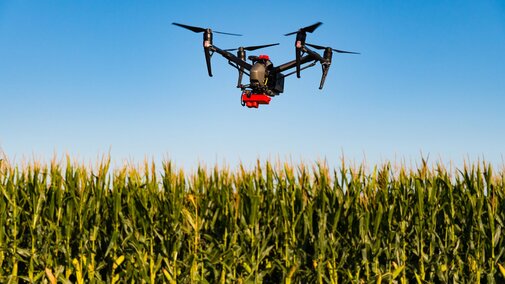Corn and wheat growers across Nebraska will be able to gain hands-on experience with cutting-edge technologies that will allow them to more precisely identify the amount of nitrogen fertilizer their crops need, while preventing excess nitrates from ending up in Nebraska’s water supply.
This opportunity comes in the form of a $1.2 million On-Farm Conservation Innovation Trials grant from the U.S. Department of Agriculture’s (USDA) Natural Resource Conservation Service (NRCS). The grant was awarded to 14 Extension Educators and 4 Extension Specialists working with Nebraska Extension’s On-Farm Research Network. The network consists of producers from across the state, who work with the University of Nebraska-Lincoln to try out new technologies and emerging practices in their own operations. Each year, between 60-70 producers and agronomists participate in between 70 and 100 trials, said Laura Thompson, an extension educator who co-coordinates the On-Farm Research Network.
Thompson said that producers involved with this project will use new technologies to more precisely apply nitrogen fertilizer to their crops. Thompson hopes that by better managing nitrogen applications, farmers will increase profits, while at the same time preventing excess nitrogen from leaching into the water supply.
“There’s a lot of potential to help farmers use real-time data to manage nitrogen more efficiently, and that will help not only with their own profitability, but with conservation of our natural resources,” Thompson said.
Technologies to be used in this trial include:
- Crop canopy sensors, which farmers can use to measure plant reflectance, which can help indicate the need for nitrogen;
- Imagery captured by drones, satellites or airplanes, which can give producers an overview of field conditions and also measure plant reflectance;
- Crop nitrogen simulation models, which can incorporate weather and soil conditions to predict nitrogen needs;
- Nitrification and urease inhibitors, which can be mixed with some fertilizers in order to reduce loss of nitrogen from fields.
These technologies may be cost-prohibitive for producers to try out on their own, Thompson said, or farmers may not have the background and training to use them effectively.
“One of our goals is to help farmers get exposure to these technologies in their own operations,” Thompson said. “This will help them determine if these technologies are a good fit for them and if they should adopt them in their operations.”
In turn, the university can evaluate and improve the technologies on real, working farms across Nebraska’s diverse crop production environments.
The On-Farm Conservation Innovation Trials grants program is a brand-new resource for institutions helping implement conservation-friendly agricultural practices.
For producers, using the right amount of nitrogen fertilizer is critically important. Use of too little can lead to significant yield loss. Use of too much can result in elevated levels of nitrate in groundwater. High levels of nitrate can lead to unsafe drinking water, as well as threats to biodiversity and the overall health of natural resources.
“The Conservation Innovation Grants program is funding the future of conservation and agriculture,” said NRCS Chief Matthew Lohr.
The grant will fund 40 trials a year for three years. Producers who wish to participate in the program can contact Thompson or visit the On-Farm Research page for more information. Those who wish to participate in the program must be Environmental Quality Incentives Program (EQIP) eligible.
Laura Thompson Extension Educator and Co-Coordinator Nebraska On-Farm Research Network 402-245-2224 laura.thompson@unl.edu
